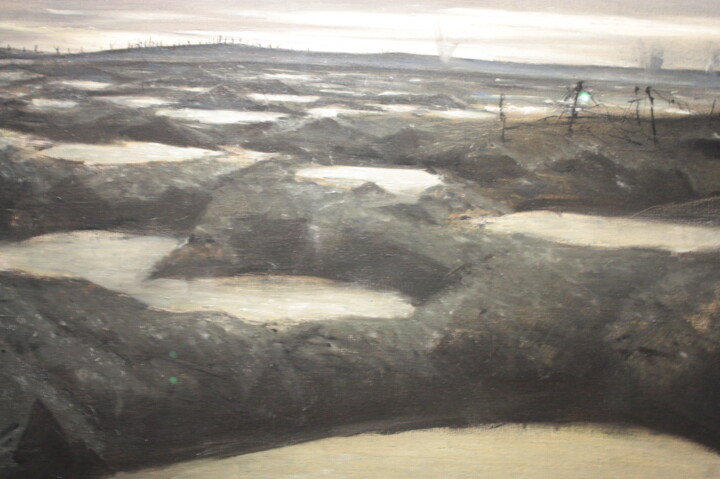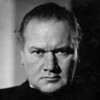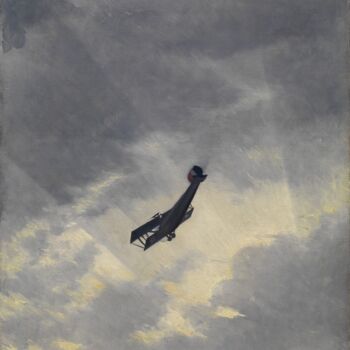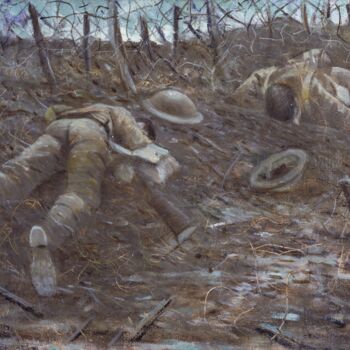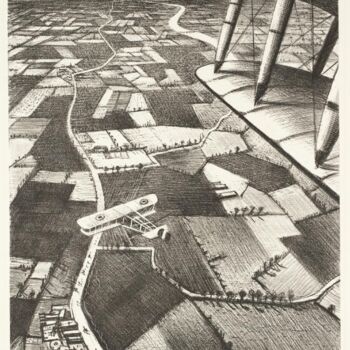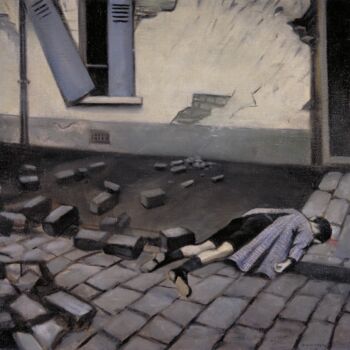After a Push (1917) Painting by Christopher Nevinson
Sold by Artmajeur Editions
Sold by Artmajeur Editions
-
Original Artwork
Painting,
Oil
on Canvas
- Dimensions Height 22.5in, Width 31.5in
- Framing This artwork is not framed
- Categories Expressionism War
La scène montre un champ de bataille dévasté après une offensive (d'où le titre "After a Push", littéralement "Après une poussée"). Les traces de l'assaut sont visibles partout : des cratères causés par les obus, des ruines d'arbres et des débris éparpillés. Le ciel est sombre, lourd de désespoir, et les nuages semblent refléter la violence qui a eu lieu au sol.
Nevinson a utilisé une palette de couleurs sombres et ternes pour renforcer l'atmosphère de désolation et de désespoir. Les tons de gris, de brun et de vert dominent la composition, soulignant le caractère lugubre de la scène.
Avec "After a Push", Christopher Nevinson s'est attaché à représenter de manière réaliste les conséquences dévastatrices de la guerre, et il a réussi à transmettre l'horreur et la désolation vécues par les soldats sur le front. Cette peinture témoigne de l'engagement de l'artiste à dénoncer les ravages de la guerre et à sensibiliser le public à la réalité brutale du conflit.
Related themes
Christopher Richard Wynne Nevinson was a British artist born August 13, 1889 in London and died October 7, 1946 in Paris. He is best known for his war paintings and depictions of the Futurist movement.
Nevinson was born into a family of artists and studied at the Slade School of Fine Art in London, where he was influenced by artists such as Paul Gauguin and Vincent van Gogh. During the First World War, he enlisted as an ambulance driver and served on the French front, which had a profound effect on his art. His wartime experiences inspired some of his most famous works, including 'The Machine Gun' and 'The Silk Road', which depict the brutality and horror of war.
After the war, Nevinson turned to the Futurist movement and incorporated elements of speed and dynamism into his paintings. His futuristic works, such as 'Save Progress', were critically acclaimed and helped popularize this art movement in the UK.
Over the years, Nevinson experimented with different artistic styles, moving from Futurism to Expressionism and Cubism. His works have been exhibited in numerous art galleries and he has become an important figure in the British art scene.
However, despite his initial success, Nevinson went through periods of artistic and financial decline. He continued to paint throughout his life, but he was somewhat forgotten by the general public. It was only after his death that his work was rediscovered and reassessed by art historians.
Today, Christopher Nevinson's paintings are housed in museums around the world, and his legacy as a major artist of the early 20th century lives on. His commitment to the realistic depiction of the horrors of war and his exploration of the Futurist movement have earned him an important place in the history of modern art.
-
Nationality:
UNITED KINGDOM

- Date of birth : 1889
- Artistic domains: Represented by a Gallery,
- Groups: Contemporary British Artists Artists presented by a gallery

